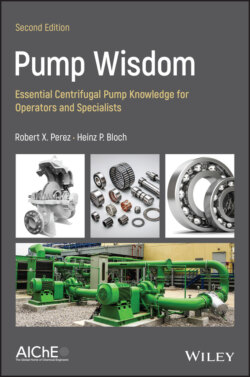Читать книгу Pump Wisdom - Robert X. Perez - Страница 26
Conventional vs. Prefilled Baseplate Installations
ОглавлениеIn general, horizontal process pumps and drivers are shipped and received as a “set” or package, i.e. already premounted on a baseplate. Seeing a conveniently mounted‐for‐shipping pump set very often leads to the erroneous assumption that the entire package can simply be hoisted up and placed on a suitable foundation. However, that's certainly not best practice and best‐in‐class (BiC) plants will not allow it.
Shipping method has little to do with how pumps should best be installed in the field, and pump installation issues merit considerable attention. Again, before installing a conventional baseplate, the pump and its driver must be removed from the baseplate and set aside. Leveling screws (Figure 3.6) are then used in conjunction with laser‐optic tools or a machinist's precision level. With the help of these tools, the baseplate‐mounting pads are brought into flat and parallel condition side‐to‐side, end‐to‐end, and also diagonally, all within an accuracy of 0.001 in./ft (~0.08 mm/m) or better. The nuts engaging the anchor bolts are being secured next, and the hollow spaces within the baseplate as well as the space between baseplate and foundation filled with epoxy grout.
The traditional approach to joining the baseplate to the foundation has been to build a liquid‐tight wooden form around the perimeter of the foundation and fill the void between the baseplate and the foundation with either a cement‐based or epoxy grout. Both grouting approaches are considered conventional and should not be confused with the preferred epoxy prefilled method which is highlighted below.
Grouting a baseplate or skid to a foundation requires careful attention to many details. A successful grout job will provide a mounting surface for the equipment that is flat, level, very rigid, and completely bonded to the foundation system. Many times these attributes are not obtained during the first attempt at grouting, and expensive field correction techniques have to be employed. Predominant installation problems involve voids and distortion of the mounting surfaces. In fact, the most frequently overlooked foundation and pipe support problems are related to foundation settling.
Figure 3.6 Steel baseplate with anchor bolt shown on left and leveling screw on right. A chock (thick steel washer) is shown between leveling screw and foundation [2].
Source: Modern Pumping Today.
How so? Just as a residential dwelling or sidewalk will probably shift, settle, and crack over time, pump foundations and supports should be expected to do the same. It would be prudent to plan for preventive or corrective action over time or during plant shutdowns. Fortunately, there is now an even better option; it involves the use of standard baseplates prefilled with epoxy.
